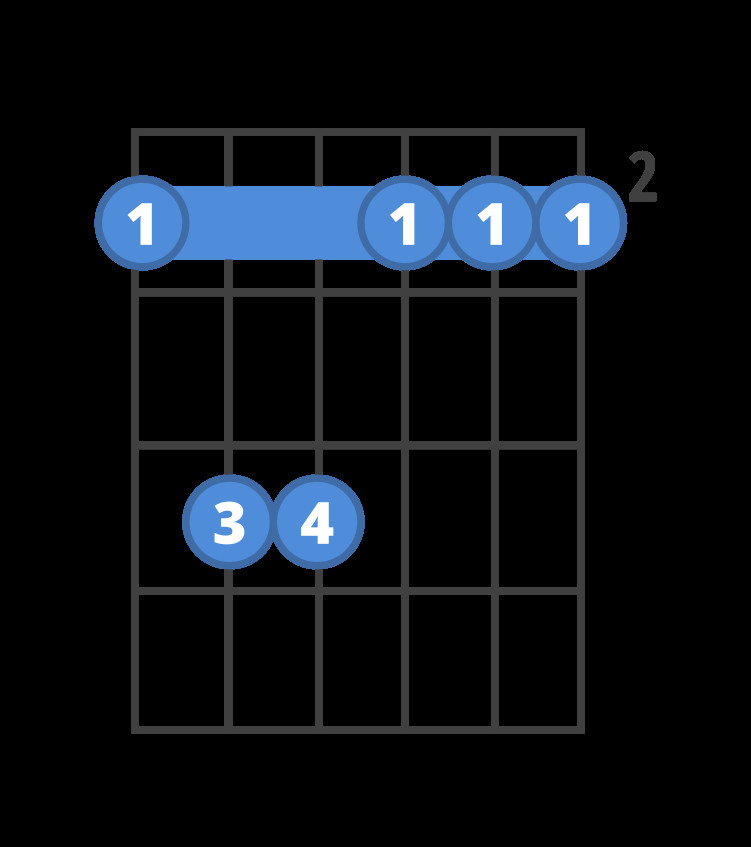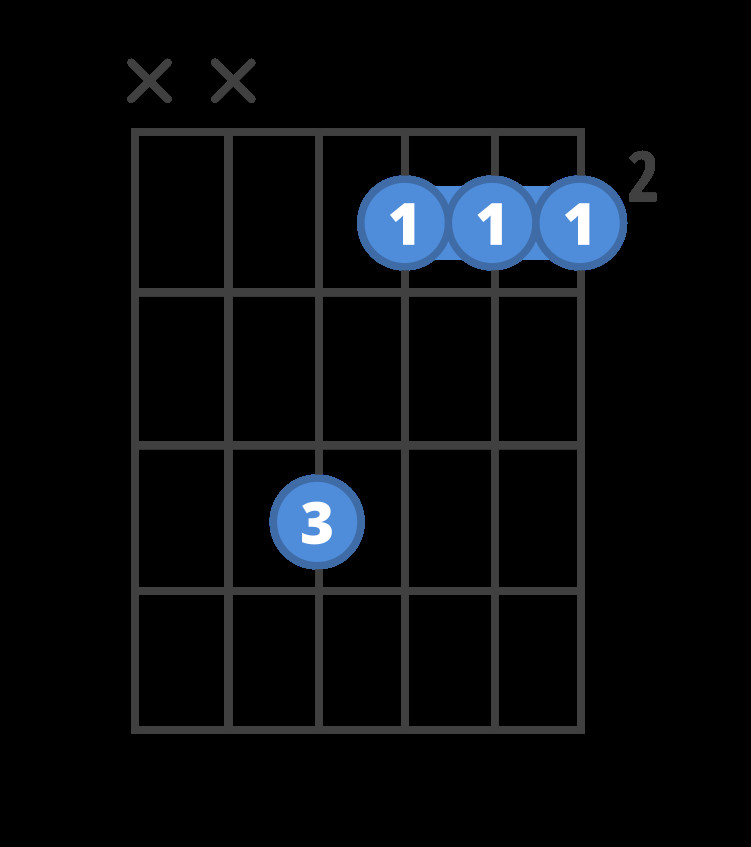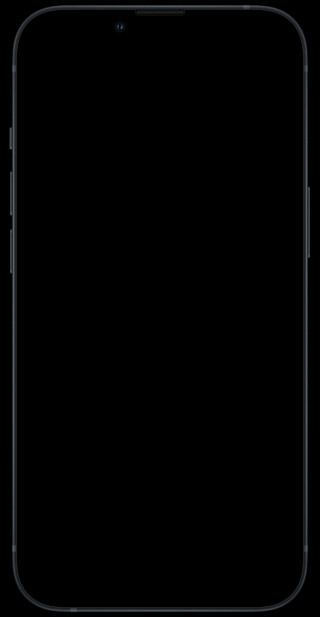The F Sharp M Guitar chord, often written as F#m, is a foundational chord in guitar playing, yet it’s notorious for being tricky, especially for beginners. If you’ve ever felt stuck trying to play an F#m, you’re definitely not alone. It consistently ranks as one of the most searched-for guitar chords online, and for good reason.
The main culprit behind its difficulty is the barre. The most common way to play F#m involves barring multiple strings with a single finger, a technique that demands finger strength and dexterity that takes time to develop. Barre chords can be a hurdle for new guitarists, but the good news is, there are multiple ways to approach the F#m chord, catering to different skill levels.
In this guide, we’ll break down three distinct ways to play the F#m chord on your guitar, starting with the most challenging and progressing to easier alternatives. Whether you’re tackling barre chords head-on or seeking a simpler entry point, we’ve got you covered.
The Classic F Sharp Minor Barre Chord
This is the version you’ll most often encounter in chord books and online resources – the textbook F#m. It’s a full barre chord and, admittedly, the toughest of the three, particularly if you’re just starting your guitar journey. But mastering this version unlocks a fundamental barre chord shape that you can use across the fretboard.
Let’s dive into how to form this classic F#m:
 Chord diagram for the Standard F#m guitar chord.
Chord diagram for the Standard F#m guitar chord.
- Index Finger Barre: Place your index finger across all six strings at the 2nd fret. Ensure you’re pressing down firmly just behind the fret to get a clean sound from every string. This barre is the foundation of the chord.
- Ring Finger Placement: Position your ring finger on the 5th string (A string) at the 4th fret. Press down with the tip of your finger.
- Pinky Finger Placement: Place your pinky finger on the 4th string (D string) at the 4th fret. Like the ring finger, use the tip to fret the string.
- Strumming: Strum all six strings from the low E string down to the high E string.
The challenge here lies in the barre. Creating a solid barre requires consistent practice to build finger strength and refine your technique. It’s about applying even pressure across all strings with your index finger while simultaneously fretting notes with your other fingers. Don’t be discouraged if it feels awkward or buzzy at first. Persistence is key!
If barre chords feel too daunting right now, don’t worry. Read on for simpler versions of the f sharp m guitar chord that can get you playing it sooner. For those ready to conquer barres, consider exploring dedicated resources on barre chord techniques to accelerate your progress.
Simplifying the Barre: An Easier F Sharp Minor
Barre chords become significantly easier when you reduce the number of strings you need to barre. This next version of the F#m chord utilizes a smaller barre, focusing on just the top three strings. This is a great intermediate step towards full barre chords and offers a more manageable way to play F#m.
Here’s how to play this simplified barre version:
 Chord diagram for the Easier Barre F#m guitar chord.
Chord diagram for the Easier Barre F#m guitar chord.
- Index Finger Mini-Barre: Place your index finger across the 1st, 2nd, and 3rd strings (high E, B, and G strings) at the 2nd fret. Focus on applying enough pressure to these three strings for them to ring clearly.
- Ring Finger Placement: Place your ring finger on the 4th string (D string) at the 4th fret.
- Strumming: Strum only the thinnest four strings, from the D string (4th string) down to the high E string (1st string). Avoid strumming the lower two strings (E and A strings).
This version is easier on the index finger because you’re barring fewer strings. It’s an excellent way to build confidence and finger strength for barre chords while still playing a recognizable f sharp m guitar chord. You’ll find this voicing useful in many songs, and it serves as a perfect stepping stone to the full barre F#m.
F Sharp Minor Without the Barre: A Beginner-Friendly Version
For absolute beginners or those who want to play an F#m chord right away without wrestling with barres, this no-barre version is your answer. It’s the simplest way to play an F#m and requires fretting only three strings, all at the same fret.
Here’s the breakdown of the no-barre F#m:
- Index Finger Placement: Place your index finger on the 3rd string (G string) at the 2nd fret.
- Middle Finger Placement: Place your middle finger on the 2nd string (B string) at the 2nd fret.
- Ring Finger Placement: Place your ring finger on the 1st string (high E string) at the 2nd fret.
- Strumming: Strum only the thinnest three strings – the 1st, 2nd, and 3rd strings. It’s crucial to avoid strumming the thicker, lower three strings (E, A, and D strings).
This version eliminates the barre entirely, making it incredibly accessible for beginners. While it’s a partial voicing of the f sharp m guitar chord, it captures the essential minor tonality and is perfectly usable in many musical contexts, especially when strumming simpler songs or focusing on melody lines.
Practice Makes Perfect: Mastering Your F Sharp Minor
Now that you know three ways to play the f sharp m guitar chord, the next step is practice. Consistent, focused practice is the key to making these chord shapes feel natural and sound great.
Barre Chord Lessons and Resources
If you’re aiming to master the barre chord versions of F#m (and you should!), dedicated instruction can be incredibly helpful. Consider exploring video lessons and guides specifically designed to demystify barre chords. These resources often provide valuable tips on technique, finger placement, and exercises to build strength and eliminate fret buzz.
 Barre chord lesson promotion image.
Barre chord lesson promotion image.
Practice Tools and Games
To make your practice sessions more engaging and effective, leverage tools designed for guitar learners. ChordBank, for instance, offers interactive games and smart flashcards specifically tailored for learning chords like F#m. These tools can make the process of memorizing finger positions and chord changes much more enjoyable.
Using games like ChordPOP! or Blackjack within the ChordBank app can turn chord practice into a fun activity. These games listen to your guitar playing via your device’s microphone and provide real-time feedback as you play the f sharp m guitar chord and others.
 iPhone displaying ChordPop game for F#m chord practice.
iPhone displaying ChordPop game for F#m chord practice.
 iPhone displaying ChordPop game for F#m chord practice.
iPhone displaying ChordPop game for F#m chord practice.
Smart flashcards are another powerful tool for building muscle memory and smooth chord transitions. Practice switching between F#m and other common chords like A major, D major, and E major to develop fluency.
 iPhone displaying ChordPop game for F#m chord practice.
iPhone displaying ChordPop game for F#m chord practice.
Conclusion
The f sharp m guitar chord might seem challenging at first, especially the barre chord version. However, by understanding the different approaches – from the full barre to the no-barre option – you can find a way to play F#m that suits your current skill level. Remember, consistent practice, combined with the right resources and tools, will lead you to mastery. Start with the version that feels most comfortable and gradually work your way towards the full barre F#m as your finger strength and technique improve. Happy playing!
